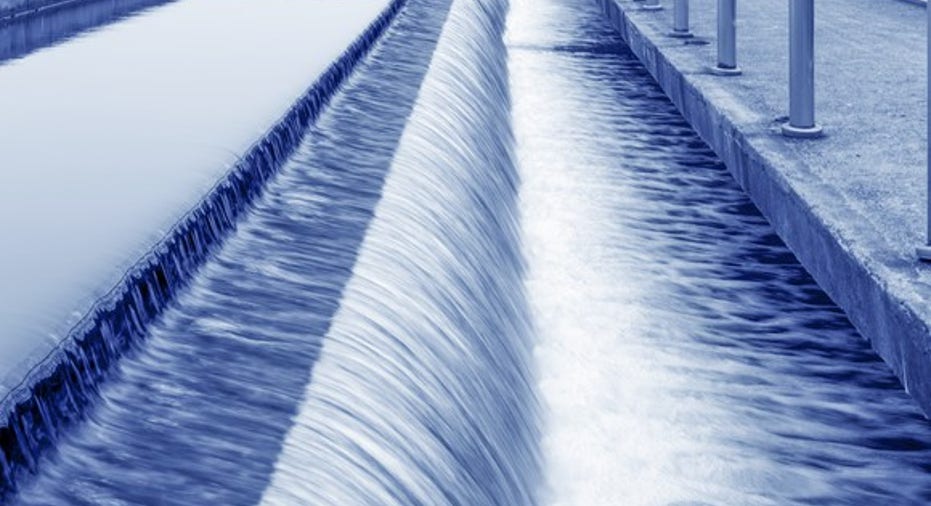Sabesp's First-Quarter Earnings Show How a Water Utility Can Perform Without a Drought

Last quarter, Companhia de Saneamento Basico do Estado de Sao Paulo(NYSE: SBS)-- more commonly known as Sabesp -- continued a streak of improving earnings results as drought conditions and foreign exchange problems became less of a factor. This most recent quarter was a continuation of that as the company posted growing top- and bottom-line results.
Here's a quick look at the company's most recent results and what investors can expect in the future.
Image source: Getty Images.
Sabesp's results: The raw numbers
| Metric* | Q1 2017 | Q1 2016 | Growth (YOY) |
|---|---|---|---|
| Revenue | $1,140 million | $970 million | 17.5% |
| Adjusted EBITDA** | $433.7 million | $290.9 million | 49.1% |
| Net income | $216.2 million | $201.5 million | 7.3% |
| Earnings per share | $0.317 | $0.295 | 7.3% |
*Results were converted to U.S. currency at a rate of 1USD = 3.12BRL **EBITDA= earnings before interest, taxes, depreciation, and amortization. Source: Sabesp earnings release.
When it comes to Sabesp's results, probably the more important number to look at here is adjusted EBITDA even though it isn't a generally accepted accounting principles (GAAP) metric. The reason this one is important this time around is it removes all financial related costs or gains. This quarter's adjusted EBITDA results were much better as the company no longer needs to pay out customers as part of its Water Consumption Reduction Incentive Program that was necessary when the Sao Paolo region was amid a severe drought. During the first quarter of 2016, more than 30% of Sabesp's customers received a 30% bonus on their bills for reduced water consumption.
The line item that makes net income results look less robust than EBITDA was foreign currency related. This time last year, Sabesp realized a one-time foreign exchange gain of $141 million related to the value of its debts not denominated in local currency. As it stands today, 47% of Sabesp's outstanding debt is denominated in foreign currency. This can have drastic impacts on bottom-line results because all of Sabesp's revenue and operations are in local currency, so there are no foreign currency revenues to offset those debtvalue fluctuations.
What happened with Sabesp this quarter?
- Total billed water and sewer volumes increased 6.1% and 5.9%, respectively. Some of that came from more water and sewer connections to the system -- up 2.7% and 3.2%, respectively -- and higher consumption per connection -- up 12% year over year. Sabesp's coverage rates for water and sewage were 98% and 89%, respectively, at the end of the quarter. Furthermore, wastewater treatment levels stood at 74%.
- Rainfall over the past six months has been 6% below the historical average for its Cantareira system, and total inflows into the system were71% of the historical average. These rates are of slight concern, but they are well above inflow rates we saw from 2013-2015 when the region was in a severe drought. The company is also working on several projects this year, and next that should improve system inflow rates by 13.5%
- Sabesp's net debt-to-adjusted EBITDA ratio declined to 1.9 at the end of the quarter. This is the lowest debt ratio the company has had since 2013.
10-second takeaway
Sabesp is in a much better position both operationally and financially than it was just a few years ago. Better inflows from an OK rainy season, fewer payouts for consumption reduction incentives, and overall growth of its water and sewer businesses have all played their part in improving Sabesp's net income results. What's even more promising is that the company's balance sheet is looking better because management has committed to a $4.45 billion capital spending plan over the next five years to improve water supply, increase total water and sewer collection, and improve wastewater treatment.
The one variable when it comes to Sabesp that investors have no control over is foreign exchange rates and the impact it has on the finances of the company. While Sabesp has benefited in recent quarters from a strengthening real, much of thathas been wiped out by the recent bribery scandal. One way to make this less of a problem in the future would be to reduce its exposure to foreign currency-denominated debt. If it could do that, then it could make exchange rate fluctuations a non-issue for the business -- although for U.S.-based investors, it will have an impact on dividend payments.
10 stocks we like better than Companhia de Saneamento BasicoWhen investing geniuses David and Tom Gardner have a stock tip, it can pay to listen. After all, the newsletter they have run for over a decade, Motley Fool Stock Advisor, has tripled the market.*
David and Tom just revealed what they believe are the 10 best stocks for investors to buy right now... and Companhia de Saneamento Basico wasn't one of them! That's right -- they think these 10 stocks are even better buys.
Click here to learn about these picks!
*Stock Advisor returns as of May 1, 2017
Tyler Crowe has no position in any stocks mentioned. The Motley Fool recommends Companhia de Saneamento Basico. The Motley Fool has a disclosure policy.



















